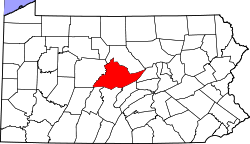Bald Eagle Valley, Pennsylvania | |
|---|---|
 A wave window over the Bald Eagle Valley looking north from Port Matilda. The Allegheny Front, which forms the wave, is under the left edge of the window. | |
 Bald Eagle Valley region of Centre County, Pennsylvania (not including Clinton County) | |
| Country | United States |
| State | Pennsylvania |
| County | Centre Clinton |
| Settled | 1769 |
| Named after | Chief Woapalanne |
| Time zone | UTC-5 (Eastern (EST)) |
| • Summer (DST) | UTC-4 (EDT) |
| Area code | 814 |
Bald Eagle Valley is a low-lying area in Pennsylvania that drains into Bald Eagle Creek between the Allegheny Front and Bald Eagle Mountain, south of the West Branch Susquehanna River, in the Ridge-and-valley Appalachians. The valley is located southwest of West Branch Susquehanna Valley and includes Williamsport, Nittany Valley, and State College in the central portion of Centre County and southern portion of Clinton County.
Contents
- Geography
- History
- Municipalities
- Boroughs
- Townships
- Census-designated places
- Agriculture
- Transportation
- Roads
- Canal
- Rail
- Air
- Geology
- External links
- References
The valley runs from Port Matilda down to Lock Haven, and it includes most of the Bald Eagle Area School District and Bald Eagle Township. Bald Eagle State Park is in the valley; the park includes the Joseph Foster Sayers Reservoir around Howard, a prominent topographic feature formed by damming Bald Eagle Creek.


